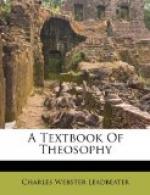Chapter IV
THE EVOLUTION OF LIFE
All the impulses of life which I have described as building the interpenetrating worlds come forth from the Third Aspect of the Deity. Hence in the Christian scheme that Aspect is called “the Giver of Life”, the Spirit who brooded over the face of the waters of space. In Theosophical literature these impulses are usually taken as a whole, and called the First Outpouring.
When the worlds had been prepared to this extent, and most of the chemical elements already existed, the Second Outpouring of life took place, and this came from the Second Aspect of the Deity. It brought with it the power of combination. In all the worlds it found existing what may be thought of as elements corresponding to those worlds. It proceeded to combine those elements into organisms which it then ensouled, and in this way it built up the seven kingdoms of Nature. Theosophy recognizes seven kingdoms, because it regards man as separate from the animal kingdom and it takes into account several stages of evolution which are unseen by the physical eye, and gives to them the mediaeval name of “elemental kingdoms”.
The divine Life pours itself into matter from above, and its whole course may be thought of in two stages—the gradual assumption of grosser and grosser matter, and then the gradual casting off again of the vehicles which have been assumed. The earliest level upon which its vehicles can be scientifically observed is the mental—the fifth counting from the finer to the grosser, the first on which there are separated globes. In practical study it is found convenient to divide this mental world into two parts, which we call the higher and the lower according to the degree of density of their matter. The higher consists of the three finer subdivisions of mental matter; the lower part of the other four.




